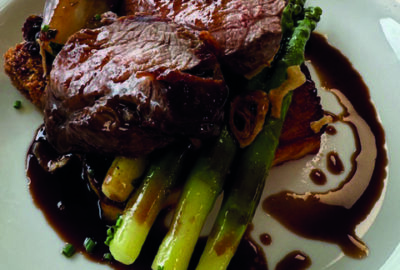As this issue of Stir it up is a Street Food Edit, it seems fitting that we dedicate our Melting Pot to sharing street food inspired dishes from some of the country’s leading chefs.
What works as a street food concept might not always translate exactly onto mainstream menus, so it’s important to adapt the latest trends to suit your customer base.
So, which street-food inspired dishes can we expect to steal a march onto 2020 menus, and how can the populus re-create them? Here are some innovative ideas…
Dev Biswal
Asian Chef of the Year and chef-patron of the Ambrette restaurants in Canterbury and Margate, and the Devil in Rye
I believe that the best way to experience culture of a place is through its street food. A few years ago, I was heavily inspired by fried crickets and grasshoppers from the streets of Bangkok and designed a six course menu around bugs. Some of the most popular dishes on my menu are street food inspired. Poori (unleavened, deep-fried bread) is a trademark street food dish in India and is eaten in various shapes and forms throughout the country. I used to eat masala papdi (a vegetarian street food snack made with green pea and fried chick pea flour crispies) as a boy in South Eastern India. It features on my menu today.
Dosai (a cooked thin-layered rice batter) – the highest selling vegetarian dish in all my restaurants is a street food dish from South India.
Chris Williams
co-founder of Silk Rd, Liverpool
Starting with the growth of tapas in the Noughties, the food scene has exploded with street food pop-ups and ‘markets’. This quest for new flavours isn’t set to stop and as a restaurateur it is key that we keep ahead of the pack. Big trends for this year are for even more growth in vegan offerings, exploring further into Middle Eastern and Asian flavours and to adapt well-known dishes. This can be seen with the growth of ‘Pavs’ or, as we know it, burgers – these really can be an explosion of flavour in a bun. Pavs are a popular Indian street food snack comprising of spiced, deep-fried potato in a bread bun garnished with chutney.
Steven Cross
LACA School Chef of the Year, who works at Park Community School, Havant, Hampshire
We introduced a new Korean/Japanese street food inspired dish onto our school menus last month, offering pulled pork, which is reared on our school farm, or pulled
jackfruit for vegans and vegetarians on a steamed bao bun. We serve them with either kimchi salad or a rainbow vegetable salad (made from spaghetti shaped strings of vegetables such as courgette and carrot), and sticky sesame noodles. It ticks all the boxes nutrientswise and looks like it has come from a trendy high street restaurant.
Stephen Gomes
TV chef and executive chef of DUSK, a fusion restaurant in Brentwood
Panipuri is a type of snack from the Indian subcontinent. It consists of a round, hollow puri, deep-fried crisp crêpe and filled with a mixture of flavoured water, tamarind chutney, chili, chaat masala, potato, onion or chickpeas. My version in Dusk is a modern and innovative method because I use a jet chill so the flavoured water comes out with smoke – and refreshingly chilled – with the help of Co2.
Stephen Hargreaves
CEO of Hargreaves Enterprises which owns Pacific street food venue Baha in Bowness-on-Windermere
The Panko Fish Bao Bun plays on the classic British dish, the ‘fish butty’, but throws in a Pan Asian twist. Packaged in a freshly steamed bao bun, panko deep-fried haddock is garnished with a fingered lime tartar sauce. It brings together Australian, Taiwanese and British ingredients to create an unorthodox menu item which has its roots in street food cuisine. The real showpiece of this dish are the finger limes known as ‘citrus caviar’. These pearls burst in your mouth to unleash strong, tart flavours which complement fatty fried foods. This simple but refreshing bao bun should give chefs a playful reminder that it’s possible to take classic well-known dishes that your customers will recognise and turn it on its head. There’s nothing in this panko haddock bao bun that most people wouldn’t have tried before, but it’s how you use the ingredients and existing flavour profiles to maximise the potential of what you’re serving.
Nick Deverell-Smith
of The Churchill Arms, Paxford, Cotswolds
This summer we took The Churchill Arms on the road, popping up at Tom Kerridge’s Pub In The Park festivals and offering street food versions of some of the dishes found on our menus at The Churchill Arms. Our lobster arancini with homemade shellfish mayo was a hit throughout and our vegan spiced butternut squash with curried lentils was really popular too. I think vegan dishes and meat replacements such as ‘jackfruit’ and ‘seitan’ will continue to be popular in street food trends for 2020 as a reaction to changing consumer food habits and more people seeking meat alternatives.
James Ball
chef director of Oakhouse Kitchen, a consultancy offering advice for people with medical diets
When you think about food for dysphagia diets it’s easy to think of care home staples – lamb casseroles with carrots and broccoli perhaps? However there’s really no limitation on what can be on offer once a few simple techniques are understood.
Street food classics like masala dosa, chicken fajitas or even hot dogs with caramelised onions and relish are easy achievable and bring great flavour and complexity to diets that can lack textural stimulation.
As tastes change within the population with swallowing difficulties it will be so important to be able to offer foods that people really want, remind them of trips they once took and allow then to re-live those wonderful memories. For recipes visit www.oakhouse -kitchen.com
Dominic Lacaba
founder and main chef of Kanto in Belfast
Kanto, which means ‘street corner’, is an Asian fusion fast food restaurant where we aim to produce the best food from all around Asia. We kept our menu simple, featuring the most favourite street food dishes in Asia. We only use the freshest ingredients locally. We implement good flavours by using our homemade sauces for marinating our meat to bring a unique taste to Kanto food. Wok stir-fry the vegetables alongside our grilled BBQ chicken, adding fresh garlic, soy sauce and sesame oil. Finishing it up with our own teriyaki sauce inspired by a Japanese cuisine with a twist.
Robin Dudley
business development chef for Essential Cuisine
Korean food continues to be popular especially when fused with American and Mexican fast food dishes. Sweet, sour and spicy flavours produce delicious comfort food, paired with fermented and umami flavours of kimchi and soy. Chefs and caterers are experimenting with different cooking techniques with this diverse cuisine such as marinating, deep frying and slow cooking to create vibrant moreish dishes. We have created a Korean Fried Chicken recipe perfect for sharing (or not if preferred!) It’s a firm menu favourite, it packs a flavour punch and is so easy to make. Simply coat the raw chicken in the flour mix, dip in the pre-mixed batter, and fry – done! Great served with Korean BBQ Sauce as a dipping pot.
Ben Bartlett
celebrity chef and brand ambassador for Lion sauces from AAK Foodservice
We’ve moved from talking about a global larder to a global banquet, with multi-cuisine menus showcasing ingredients and influences from
around the world, representing almost every culture and region. When it comes to street food, it’s all about getting the basics right and adding great sauces.
Grill some really good quality chicken or roast some tofu and vegetables. Then add Middle Eastern hot sauce for a North African dish; or drizzle Indian spiced lemon dressing and it’s fragrantly South Asian. Japanese teriyaki BBQ sauce turns it Tokyo-inspired, while basil oil dressing is a beautifully simple way to create a Mediterranean masterpiece.


